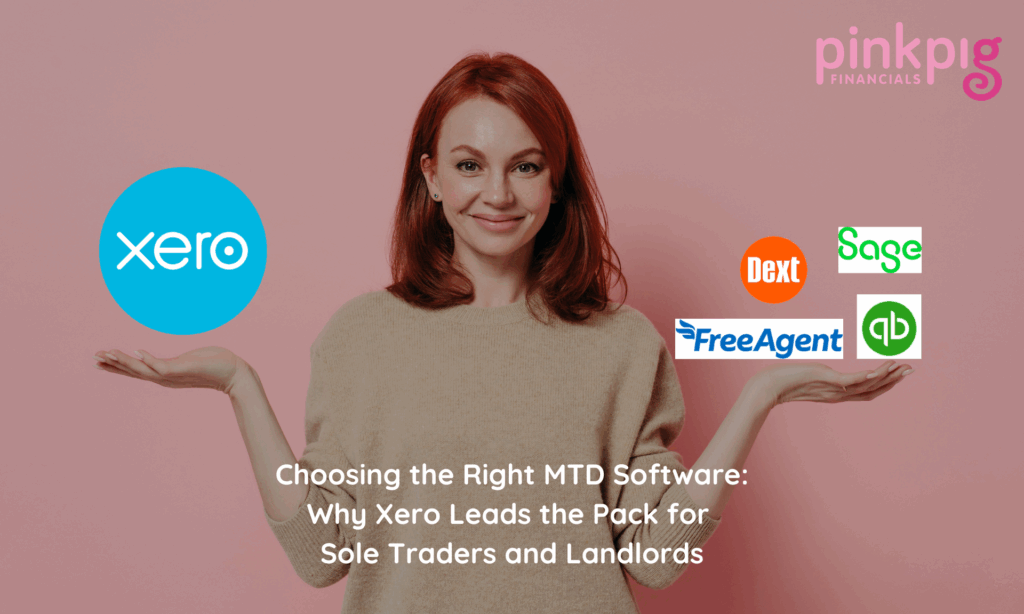Making Tax Digital for Income Tax is coming, and if you’re a sole trader or landlord, you’ll need compliant MTD software to manage your tax obligations from April 2026. While the technical requirements might seem daunting, choosing the right software can actually make your life easier and save you money in the long run.
As Xero partners, we’ve spent considerable time evaluating the options available, so you don’t have to!
Here’s our honest comparison of the leading MTD software solutions and why we believe Xero comes out on top.
The Software Landscape: Your Main Options
The market offers several MTD-compliant solutions, each with different strengths and limitations. Let’s look at how Xero compares to the main alternatives: QuickBooks, Sage, FreeAgent, and Dext Solo.
Xero vs QuickBooks: The Clear Winner for UK Businesses
Invoicing and Payments
While both platforms offer invoicing, Xero’s integrated payment options give it a significant edge. Xero supports Tap to Pay, Buy Now Pay Later, and seamless integrations with Stripe, GoCardless, and PayPal. QuickBooks offers invoicing but lacks integrated payment services.
This means your customers can pay directly from Xero invoices, leading to faster payments and improved cash flow. It also creates a more professional experience for your clients.
Multi-Income Filing
Here’s where Xero really shines for our typical clients. If you’re a sole trader with rental properties, Xero allows you to manage multiple income streams within a single organisation. QuickBooks’ implementation for this remains unclear, potentially requiring separate subscriptions.
Bank Reconciliation
Xero handles bank feeds and reconciliation in one seamless step. QuickBooks requires a two-step process where you first process the bank feed, then manually reconcile in a separate area. For busy business owners, this time-saving feature alone makes a difference.
App Integrations
Xero’s open ecosystem allows integration across industries and functions, making the transition to MTD compliance smoother. QuickBooks doesn’t offer app integration functionality, limiting your ability to customise your workflow.
Xero vs Sage: Value Beyond the ‘Free’ Label
The Reality of ‘Free’ Software
Sage offers a free individual plan, but here’s what they don’t tell you upfront. The free version limits you to one bank feed with all other inputs entered manually. Xero’s automation features for bank feeds, reconciliation, and data capture are built-in from the start.
While ‘free’ sounds appealing, the manual workload adds up quickly. Xero’s automation saves hours, reduces errors, and makes staying compliant much easier.
Multi-Income Complexity
Like QuickBooks, Sage requires separate subscriptions for different income streams. If you’re a sole trader with rental income, you’d need multiple subscriptions to stay compliant. Xero handles this within one organisation, keeping costs down and simplifying your setup.
Payment Integration
Sage’s individual free plan doesn’t include invoicing, and their paid plans lack integrated payment options. Again, Xero’s comprehensive payment solutions create a better experience for both you and your customers.
Xero vs FreeAgent: Better Value and Flexibility
Pricing Comparison
Xero Simple, which includes full MTD capabilities, costs £7 per month. FreeAgent’s landlord subscription is £10 per month, with their sole trader plan at £19 per month. For the same functionality, you’re paying significantly less with Xero.
Multi-Income Filing
FreeAgent’s property pages are only available in the landlord subscription plan. If you have both self-employment and property income, you’d need multiple subscriptions. Xero handles both within one organisation at a lower cost.
Data Capture
Xero Simple includes Hubdoc at no extra cost for unlimited document processing. FreeAgent limits you to 10 free bills per month, then charges an additional £5 monthly for more usage. True cost transparency matters when budgeting for your business.
Practice Solution
FreeAgent doesn’t currently offer partnership tax return submission, limiting accountants who need to manage everything within one ecosystem. Xero offers a complete end-to-end solution covering most client types.
Xero vs Dext Solo: Proven vs Experimental
Track Record
Xero has been tried and tested by thousands of small businesses globally. Dext Solo only recently launched its invoicing feature and remains untested at scale. When compliance is at stake, proven reliability matters.
Scalability
Xero offers a suite of products that support business growth. Dext Solo is only suitable for simple MTD clients and shifts to being a pre-accounting tool rather than a complete solution as businesses grow. This means you’d likely need to switch platforms later, creating additional costs and disruption.
Property Management
For landlords with joint ownership, Xero allows clear setting of ownership percentages and consolidated filing. Dext Solo requires separate bookkeeping per taxpayer with no shared access to property records, creating unnecessary duplication and complexity.
Why Xero Works for Real Businesses
Let’s look at some practical scenarios:
Sarah the Consultant: She runs a marketing consultancy as a sole trader and owns two rental properties with her partner. With Xero, she manages everything in one place, sets ownership percentages for the properties, and files consolidated returns. Her clients pay invoices faster thanks to integrated payment options, improving her cash flow.
Mike the Landlord: He owns five rental properties, some jointly with his wife. Xero’s property apportionment features let him keep all records in one place while ensuring accurate filings for jointly-owned properties. He avoids the cost and complexity of multiple subscriptions.
Emma the Freelancer: She’s a graphic designer with growing income who occasionally takes on property projects. Xero’s scalability means she won’t need to switch platforms as her business grows, avoiding retraining costs and maintaining continuity.
The Bottom Line
While several software options claim MTD compliance, Xero consistently delivers better value through:
- Lower overall costs, especially for multi-income businesses
- Superior automation that saves time and reduces errors
- Integrated payment solutions that improve cash flow
- Scalability that grows with your business
- Proven reliability with thousands of UK businesses
MTD compliance doesn’t have to be complicated or expensive. The right MTD software choice can actually streamline your processes and improve your business operations.
Getting MTD Ready
Choosing compliant software is just the first step. You’ll also need to ensure your records are properly set up, understand the filing requirements, and have processes in place for ongoing compliance.
If you’d like guidance on choosing the right MTD solution for your specific situation or help getting your systems ready for the transition, we’re here to help.
Book a discovery call with us to discuss your needs and get practical advice tailored to your business.
We’ll even share some quick wins you can implement right away, whether you decide to work with us or not.

